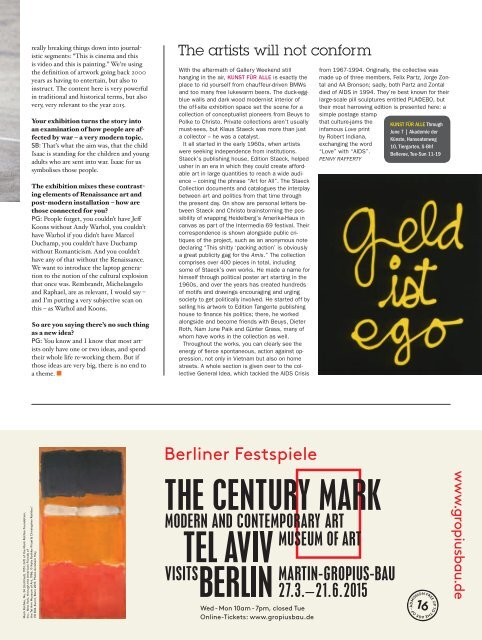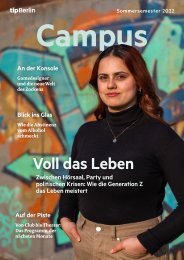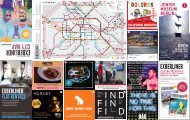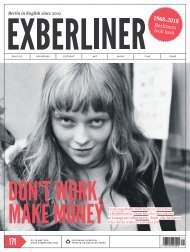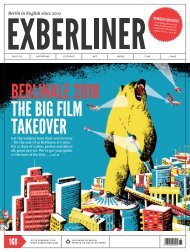Create successful ePaper yourself
Turn your PDF publications into a flip-book with our unique Google optimized e-Paper software.
eally breaking things down into journalistic<br />
segments: “This is cinema and this<br />
is video and this is painting.” We’re using<br />
the definition of artwork going back 2000<br />
years as having to entertain, but also to<br />
instruct. The content here is very powerful<br />
in traditional and historical terms, but also<br />
very, very relevant to the year <strong>2015</strong>.<br />
Your exhibition turns the story into<br />
an examination of how people are affected<br />
by war – a very modern topic.<br />
SB: That’s what the aim was, that the child<br />
Isaac is standing for the children and young<br />
adults who are sent into war. Isaac for us<br />
symbolises those people.<br />
The exhibition mixes these contrasting<br />
elements of Renaissance art and<br />
post-modern installation – how are<br />
those connected for you?<br />
PG: People forget, you couldn’t have Jeff<br />
Koons without Andy Warhol, you couldn’t<br />
have Warhol if you didn’t have Marcel<br />
Duchamp, you couldn’t have Duchamp<br />
without Romanticism. And you couldn’t<br />
have any of that without the Renaissance.<br />
We want to introduce the laptop generation<br />
to the notion of the cultural explosion<br />
that once was. Rembrandt, Michelangelo<br />
and Raphael, are as relevant, I would say –<br />
and I’m putting a very subjective scan on<br />
this – as Warhol and Koons.<br />
So are you saying there’s no such thing<br />
as a new idea?<br />
PG: You know and I know that most artists<br />
only have one or two ideas, and spend<br />
their whole life re-working them. But if<br />
those ideas are very big, there is no end to<br />
a theme. ■<br />
The artists will not conform<br />
With the aftermath of Gallery Weekend still<br />
hanging in the air, KUNST FÜR ALLE is exactly the<br />
place to rid yourself from chauffeur-driven BMWs<br />
and too many free lukewarm beers. The duck-eggblue<br />
walls and dark wood modernist interior of<br />
the off-site exhibition space set the scene for a<br />
collection of conceptualist pioneers from Beuys to<br />
Polke to Christo. Private collections aren’t usually<br />
must-sees, but Klaus Staeck was more than just<br />
a collector – he was a catalyst.<br />
It all started in the early 1960s, when artists<br />
were seeking independence from institutions.<br />
Staeck’s publishing house, Edition Staeck, helped<br />
usher in an era in which they could create affordable<br />
art in large quantities to reach a wide audience<br />
– coining the phrase “Art for All”. The Staeck<br />
Collection documents and catalogues the interplay<br />
between art and politics from that time through<br />
the present day. On show are personal letters between<br />
Staeck and Christo brainstorming the possibility<br />
of wrapping Heidelberg’s Amerika-Haus in<br />
canvas as part of the Intermedia 69 festival. Their<br />
correspondence is shown alongside public critiques<br />
of the project, such as an anonymous note<br />
declaring “This shitty ‘packing action’ is obviously<br />
a great publicity gag for the Amis.” The collection<br />
comprises over 400 pieces in total, including<br />
some of Staeck’s own works. He made a name for<br />
himself through political poster art starting in the<br />
1960s, and over the years has created hundreds<br />
of motifs and drawings encouraging and urging<br />
society to get politically involved. He started off by<br />
selling his artwork to Edition Tangente publishing<br />
house to finance his politics; there, he worked<br />
alongside and become friends with Beuys, Dieter<br />
Roth, Nam June Paik and Günter Grass, many of<br />
whom have works in the collection as well.<br />
Throughout the works, you can clearly see the<br />
energy of fierce spontaneous, action against oppression,<br />
not only in Vietnam but also on home<br />
streets. A whole section is given over to the collective<br />
General Idea, which tackled the AIDS Crisis<br />
from 1967-1994. Originally, the collective was<br />
made up of three members, Felix Partz, Jorge Zontal<br />
and AA Bronson; sadly, both Partz and Zontal<br />
died of AIDS in 1994. They’re best known for their<br />
large-scale pill sculptures entitled PLA©EBO, but<br />
their most harrowing edition is presented here: a<br />
simple postage stamp<br />
that culture-jams the<br />
infamous Love print<br />
by Robert Indiana,<br />
exchanging the word<br />
“Love” with “AIDS”.<br />
PENNY RAFFERTY<br />
KUNST FÜR ALLE Through<br />
June 7 | Akademie der<br />
Künste, Hanseatenweg<br />
10, Tiergarten, S-Bhf<br />
Bellevue, Tue-Sun 11-19<br />
Wed - Mon 10am - 7pm, closed Tue<br />
Online-Tickets: www.gropiusbau.de<br />
43


